


By
Tima Fofana
on
July 18, 2022
There’s never been a better time to start a podcast. With global lockdowns and restrictions being imposed during the COVID-19 pandemic, podcasting has grown, and its audiences have diversified. As we promised in our recent podcast to vodcast post, we’re going to take you through the step-by-step process of launching a podcast.
So if you’ve been sitting on a great idea, but haven’t quite figured out how to get started, you’re in the right place.
Get your podcast audio right
While content, structure, and format are all important aspects of podcast production, nothing ruins a story quite like bad audio. It’s not only distracting, it can be the sole reason why listeners hit that stop button and sadly never return. But don’t just take our word for it — a 2018 study for USC and the Australian National University discovered when 196 participants listened to identical interviews with the same academic experts, the versions with decreased audio quality made them perceive the speakers as less likable, less intelligent, and the research less important.
Find a good space to record
Great audio starts with having a good recording space. If you were sticking to an audio-only podcast, setting yourself up in a tiny closet could be a viable option, but since you wouldn’t want to miss out on all the benefits that video can bring to your podcast, we’ll be looking at this article from a vodcast perspective.
Large and open spaces with hard surfaces and reflective furniture increase the chances of echo and reverberation. If the room you plan on recording in doesn’t have a lot of furniture, fill it up with sound-absorbing items like carpets, cushions, blankets, curtains, and upholstered furniture.
Adding frames with art or photos, plants, and bookshelves will not only help reduce the echo picked up by your microphone, but it will help bring some personality into your videos as well.
It’s also a good idea to think about how much background noise you can hear in your space. Maybe it’s in a shared working space or near a busy room in your house — this could affect your recordings. To address background noise, try adding more soft furnishings, some rudimentary soundproofing, or just schedule your recording sessions wisely!
Turning an empty space in the Detail office into a purpose-built podcast studio.
Get the right gear for you
Depending on your level of experience, the format of your podcast, and your budget, there are tons of options out there and, these days, you can get quality equipment without breaking the bank.
Microphones
Another important factor when it comes to audio is, of course, your microphone. If you’re planning on having a co-host or guest, make sure each speaker has their own. A new microphone doesn’t have to break the bank. If you’re thinking of getting a USB option, the Blue Snowball by Logitech could be a good place to start. If you’re willing to splurge a bit, the Blue Yeti X, and Apogee Hype Mic are popular choices amongst podcasters.
Another option, which is great if you’re planning on recording something on the go, is using a portable and wireless microphone like RØDE’s pocket-sized solution. Even if you’re planning to record in a studio, you’ll benefit from the portability of this kind of microphone since you won’t run into issues where volume increases or decreases when people move towards or away from the microphone.
You might be looking at recording your podcast via an audio interface, in which case you’d need an XLR microphone. One of the most popular choices is pairing the RØDECaster Pro
with their PodMic. Two budget-friendly options that happen to have both USB and XLR outputs are Samson Technologies Q2U and Audio-Technica ATR2100x. For those willing to spend a bit more money, the Shure SM7B is a favorite amongst pros.
Tip for beginners: Setting your mic up on top of a soft surface like a pet bed will help remove reverb in your recordings.
Headphones
While many would argue that headphones are optional, there are lots of good reasons to wear them when recording a podcast. They can help you tell how your podcast will sound over headphones, monitor your audio quality, and let you know if any areas of your recording need improving. Check out this list we found of The 13 Best Podcast Headphones For Every Budget.
Lighting
We talked a bit about lighting in our previous podcasting post and recommended some relatively inexpensive key lights like the Elgato key light or the Edge Desk Light. But there’s a whole host of cheaper, generic options available on sites like Amazon (of course the quality varies so check those reviews!)
Alongside key and fill lights, you can use an RGB LED backlight to add color and warmth to your setup. At Detail, we often use these Philips Hue lights but there are also some more affordable options available like CharKee LED Strip Lights and APEKS Smart.
Setting up your podcast
Once you’ve got all your gear and accessories, it’s time to figure out where to put them.
Cameras
Your camera placement will depend on the format of your podcast. If you’re hosting alone, a single wide-shot camera could suffice, but if you have additional speakers, we recommend using a camera for each so you can cut back and forth between them.
Unless you already have tripods and mounts for your iPhone and/or cameras, you’ll need these for your setup. You can get stands for mounting your cameras on a desk or on the floor. For attaching an iPhone, we love the Joby Grip Tight Pro but there are endless options out there — check out this video where our CEO Paul shared his favorite mounts and stands for recording, streaming, and video calls.
This might sound like a lot of work, but with Detail you can use an iPhone, an iPad, and another camera and record all your separate angles with one click.
Lights
A common lighting setup that works well is the “3-point-lighting” system. As the name suggests, it’s made up of three lights — the key light (e.g. ring light), the fill light (softbox light, or led panel), and the background light (RGB as mentioned above).
Your key light should be the strongest one that points directly at your subjects. The fill light is there to remove any shadows that are too visible. The background light is there to gently illuminate your subject from behind, to add depth and contrast, and help them stand out from the backdrop.
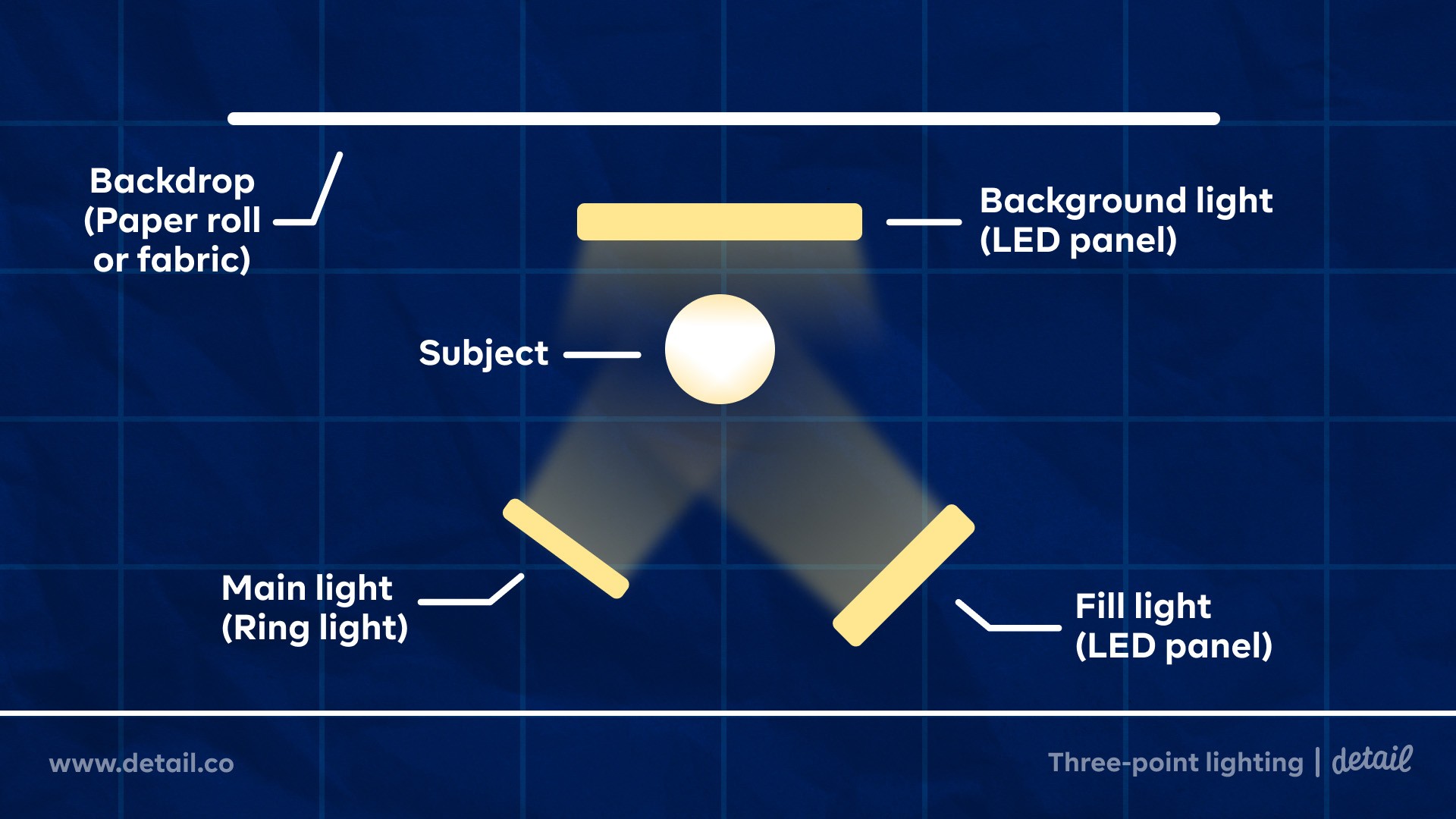
Microphones
If you’re setting up at a desk, we suggest getting a desk mount like these ones from NEEWER, and Gator Frameworks. If you’re sitting on a couch or chair, you might need a full-length floor stand like the Konig & Meyer 210/6 or, if you’re building on a budget, Moukey MMs-3.
Microphone placement is pretty straightforward. The goal is to get the best audio possible. Clip-on mics need to be attached somewhere on your subjects where they won't rustle or touch them too much. If you’re using mics attached to a mount, or stand, try not to obstruct the view of your host/guest, but do make sure it’s close enough to get good sound quality.
Furnishing your space
It might seem less important than the other gear, but making your recording space your own and adding some character can really make your podcast stand out. Think of your background as an extension of you or your brand! We recommend checking out your favorite podcasters’ setups to get inspiration for furniture layout and props — you can do a whole lot with some nice chairs and a few fake plants!
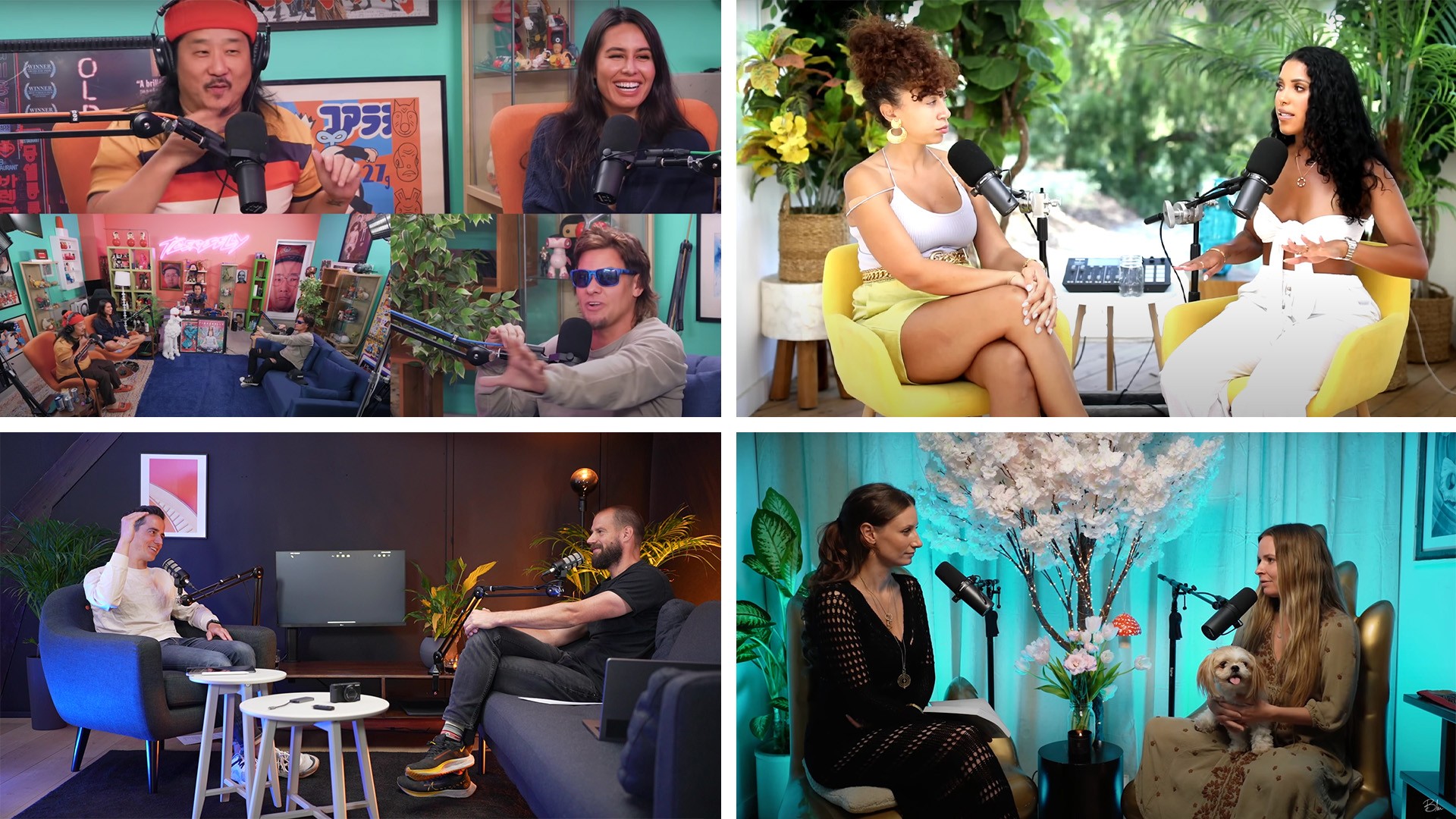
Clockwise from top left: TigerBelly, Deja Blu Podcast, The Detail Studio, Lovers & Friends.
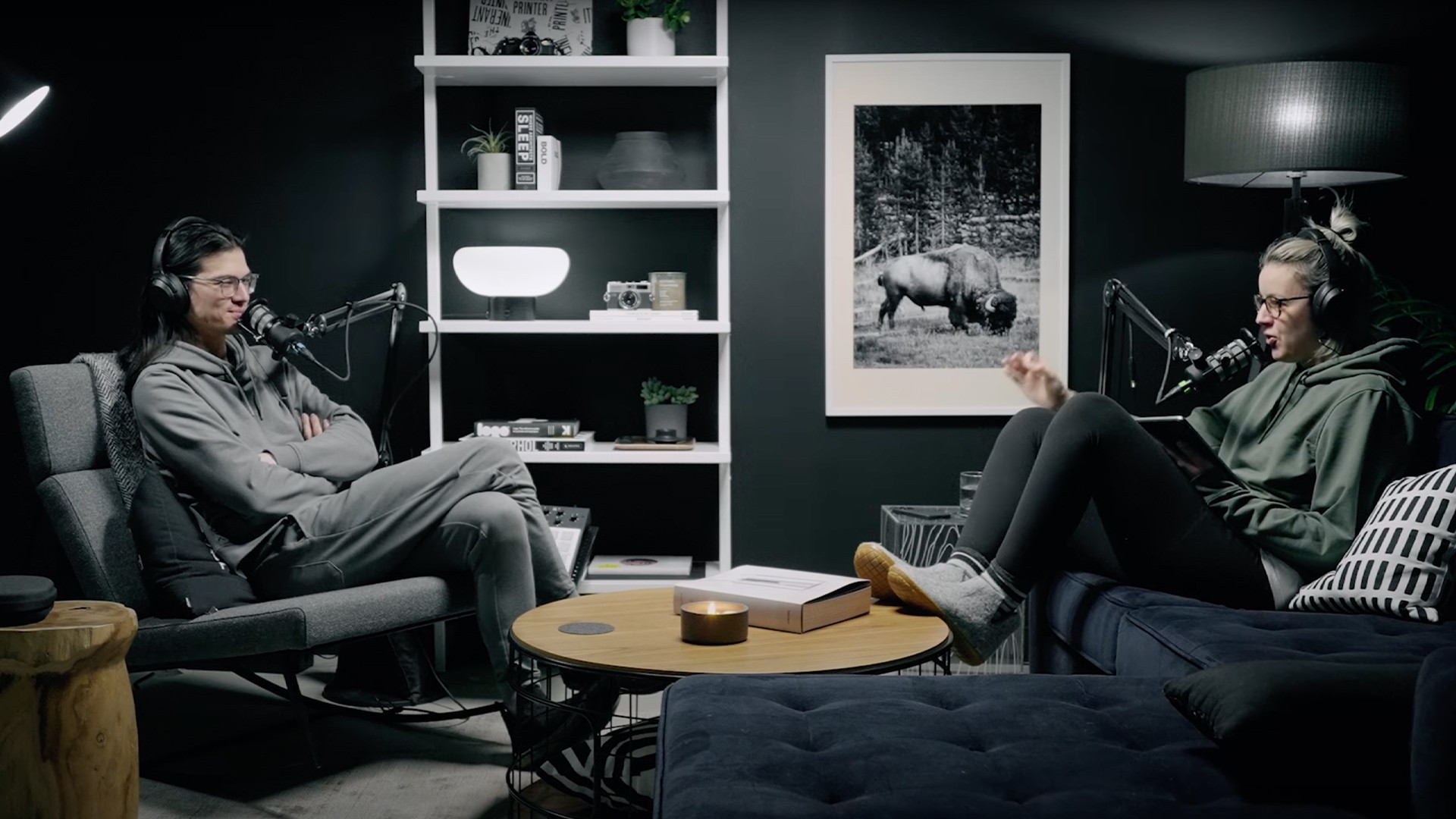
The Tuxedo Time Podcast.
Recording and editing your podcast
Whether you're a solo podcaster, have a cohost, or you’re interviewing a guest, having an outline with bullet points, or a full script could help make your speech flow better. There’s no need to write out every word you intend to say, but having notes can help you stay on topic and stick to a structure that’s easy for your listeners to follow. Check out these free script samples from the podcasting platform, Buzzprout.
If you haven’t already, download the Detail Studio app. Once you’re ready to record, launch Detail Studio on your Mac and connect your iPhones and/or cameras in the app. Start by adding each camera angle as a separate Scene.
To save you some time, we’ve created a podcasting Scene Pack that includes a set of templates with custom text, images, and filters. Don’t forget to choose your audio input in Detail Studio to ensure you get that high-quality audio we mentioned earlier.
Before you shoot your first episode, do a couple of test recordings to make sure that your audio and video sound and look good. Depending on your preference, you can edit your video in Detail after you’re done, but you can also produce the podcast while you record by switching between scenes.
Branding your podcast
Assuming you already have your podcast name and theme figured out, you need to sort out your podcast artwork. Branding plays an important role in attracting new audiences. Don’t worry if you’re not a graphic designer, Canva is a great and easy place to start if you want to play around with a couple of concepts. If you’d rather hand the design process over to a professional without spending a fortune, Fiverr is a great place to find freelance designers for every budget.
You can add branding to your podcast recordings by using text and image overlays in Detail. Thanks to the snapshot feature, you can easily create thumbnails for your videos, without the need to use additional editing programs.
Conclusion
Remember that practice makes perfect. Try different camera angles and lighting, test your audio, and hone your scripts. Everybody has to start somewhere and getting used to the sound of your own voice can be a challenge. If you’re ready to get started making your own video podcast, download Detail Studio and head over to our Youtube channel for more tips.
There’s never been a better time to start a podcast. With global lockdowns and restrictions being imposed during the COVID-19 pandemic, podcasting has grown, and its audiences have diversified. As we promised in our recent podcast to vodcast post, we’re going to take you through the step-by-step process of launching a podcast.
So if you’ve been sitting on a great idea, but haven’t quite figured out how to get started, you’re in the right place.
Get your podcast audio right
While content, structure, and format are all important aspects of podcast production, nothing ruins a story quite like bad audio. It’s not only distracting, it can be the sole reason why listeners hit that stop button and sadly never return. But don’t just take our word for it — a 2018 study for USC and the Australian National University discovered when 196 participants listened to identical interviews with the same academic experts, the versions with decreased audio quality made them perceive the speakers as less likable, less intelligent, and the research less important.
Find a good space to record
Great audio starts with having a good recording space. If you were sticking to an audio-only podcast, setting yourself up in a tiny closet could be a viable option, but since you wouldn’t want to miss out on all the benefits that video can bring to your podcast, we’ll be looking at this article from a vodcast perspective.
Large and open spaces with hard surfaces and reflective furniture increase the chances of echo and reverberation. If the room you plan on recording in doesn’t have a lot of furniture, fill it up with sound-absorbing items like carpets, cushions, blankets, curtains, and upholstered furniture.
Adding frames with art or photos, plants, and bookshelves will not only help reduce the echo picked up by your microphone, but it will help bring some personality into your videos as well.
It’s also a good idea to think about how much background noise you can hear in your space. Maybe it’s in a shared working space or near a busy room in your house — this could affect your recordings. To address background noise, try adding more soft furnishings, some rudimentary soundproofing, or just schedule your recording sessions wisely!
Turning an empty space in the Detail office into a purpose-built podcast studio.
Get the right gear for you
Depending on your level of experience, the format of your podcast, and your budget, there are tons of options out there and, these days, you can get quality equipment without breaking the bank.
Microphones
Another important factor when it comes to audio is, of course, your microphone. If you’re planning on having a co-host or guest, make sure each speaker has their own. A new microphone doesn’t have to break the bank. If you’re thinking of getting a USB option, the Blue Snowball by Logitech could be a good place to start. If you’re willing to splurge a bit, the Blue Yeti X, and Apogee Hype Mic are popular choices amongst podcasters.
Another option, which is great if you’re planning on recording something on the go, is using a portable and wireless microphone like RØDE’s pocket-sized solution. Even if you’re planning to record in a studio, you’ll benefit from the portability of this kind of microphone since you won’t run into issues where volume increases or decreases when people move towards or away from the microphone.
You might be looking at recording your podcast via an audio interface, in which case you’d need an XLR microphone. One of the most popular choices is pairing the RØDECaster Pro
with their PodMic. Two budget-friendly options that happen to have both USB and XLR outputs are Samson Technologies Q2U and Audio-Technica ATR2100x. For those willing to spend a bit more money, the Shure SM7B is a favorite amongst pros.
Tip for beginners: Setting your mic up on top of a soft surface like a pet bed will help remove reverb in your recordings.
Headphones
While many would argue that headphones are optional, there are lots of good reasons to wear them when recording a podcast. They can help you tell how your podcast will sound over headphones, monitor your audio quality, and let you know if any areas of your recording need improving. Check out this list we found of The 13 Best Podcast Headphones For Every Budget.
Lighting
We talked a bit about lighting in our previous podcasting post and recommended some relatively inexpensive key lights like the Elgato key light or the Edge Desk Light. But there’s a whole host of cheaper, generic options available on sites like Amazon (of course the quality varies so check those reviews!)
Alongside key and fill lights, you can use an RGB LED backlight to add color and warmth to your setup. At Detail, we often use these Philips Hue lights but there are also some more affordable options available like CharKee LED Strip Lights and APEKS Smart.
Setting up your podcast
Once you’ve got all your gear and accessories, it’s time to figure out where to put them.
Cameras
Your camera placement will depend on the format of your podcast. If you’re hosting alone, a single wide-shot camera could suffice, but if you have additional speakers, we recommend using a camera for each so you can cut back and forth between them.
Unless you already have tripods and mounts for your iPhone and/or cameras, you’ll need these for your setup. You can get stands for mounting your cameras on a desk or on the floor. For attaching an iPhone, we love the Joby Grip Tight Pro but there are endless options out there — check out this video where our CEO Paul shared his favorite mounts and stands for recording, streaming, and video calls.
This might sound like a lot of work, but with Detail you can use an iPhone, an iPad, and another camera and record all your separate angles with one click.
Lights
A common lighting setup that works well is the “3-point-lighting” system. As the name suggests, it’s made up of three lights — the key light (e.g. ring light), the fill light (softbox light, or led panel), and the background light (RGB as mentioned above).
Your key light should be the strongest one that points directly at your subjects. The fill light is there to remove any shadows that are too visible. The background light is there to gently illuminate your subject from behind, to add depth and contrast, and help them stand out from the backdrop.

Microphones
If you’re setting up at a desk, we suggest getting a desk mount like these ones from NEEWER, and Gator Frameworks. If you’re sitting on a couch or chair, you might need a full-length floor stand like the Konig & Meyer 210/6 or, if you’re building on a budget, Moukey MMs-3.
Microphone placement is pretty straightforward. The goal is to get the best audio possible. Clip-on mics need to be attached somewhere on your subjects where they won't rustle or touch them too much. If you’re using mics attached to a mount, or stand, try not to obstruct the view of your host/guest, but do make sure it’s close enough to get good sound quality.
Furnishing your space
It might seem less important than the other gear, but making your recording space your own and adding some character can really make your podcast stand out. Think of your background as an extension of you or your brand! We recommend checking out your favorite podcasters’ setups to get inspiration for furniture layout and props — you can do a whole lot with some nice chairs and a few fake plants!

Clockwise from top left: TigerBelly, Deja Blu Podcast, The Detail Studio, Lovers & Friends.

The Tuxedo Time Podcast.
Recording and editing your podcast
Whether you're a solo podcaster, have a cohost, or you’re interviewing a guest, having an outline with bullet points, or a full script could help make your speech flow better. There’s no need to write out every word you intend to say, but having notes can help you stay on topic and stick to a structure that’s easy for your listeners to follow. Check out these free script samples from the podcasting platform, Buzzprout.
If you haven’t already, download the Detail Studio app. Once you’re ready to record, launch Detail Studio on your Mac and connect your iPhones and/or cameras in the app. Start by adding each camera angle as a separate Scene.
To save you some time, we’ve created a podcasting Scene Pack that includes a set of templates with custom text, images, and filters. Don’t forget to choose your audio input in Detail Studio to ensure you get that high-quality audio we mentioned earlier.
Before you shoot your first episode, do a couple of test recordings to make sure that your audio and video sound and look good. Depending on your preference, you can edit your video in Detail after you’re done, but you can also produce the podcast while you record by switching between scenes.
Branding your podcast
Assuming you already have your podcast name and theme figured out, you need to sort out your podcast artwork. Branding plays an important role in attracting new audiences. Don’t worry if you’re not a graphic designer, Canva is a great and easy place to start if you want to play around with a couple of concepts. If you’d rather hand the design process over to a professional without spending a fortune, Fiverr is a great place to find freelance designers for every budget.
You can add branding to your podcast recordings by using text and image overlays in Detail. Thanks to the snapshot feature, you can easily create thumbnails for your videos, without the need to use additional editing programs.
Conclusion
Remember that practice makes perfect. Try different camera angles and lighting, test your audio, and hone your scripts. Everybody has to start somewhere and getting used to the sound of your own voice can be a challenge. If you’re ready to get started making your own video podcast, download Detail Studio and head over to our Youtube channel for more tips.
Get started with a free Scene Pack
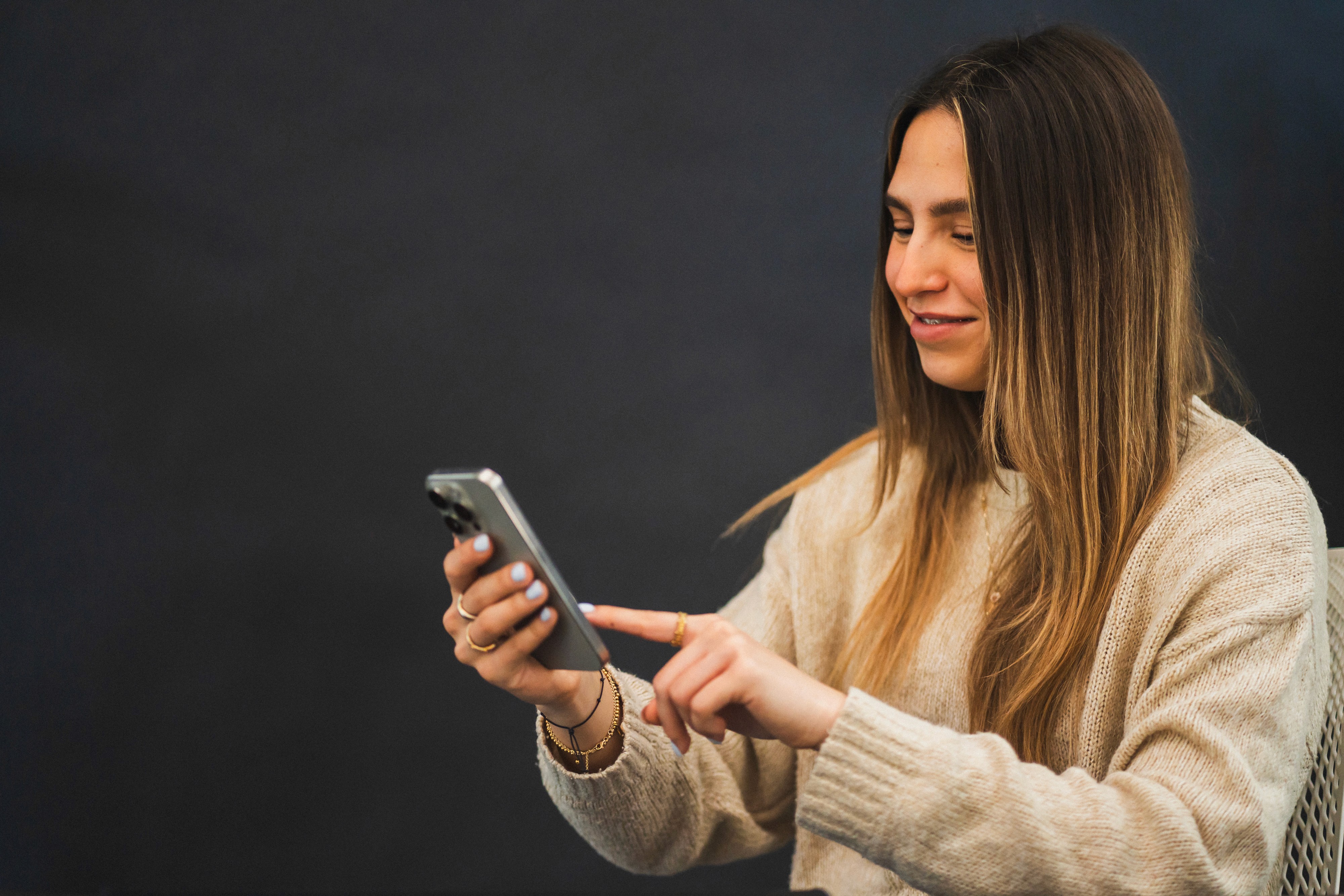

Tips & Tricks
Tips & Tricks
How to Extract Audio from Any Video on Your iPhone
How to Extract Audio from Any Video on Your iPhone
How to Extract Audio from Any Video on Your iPhone
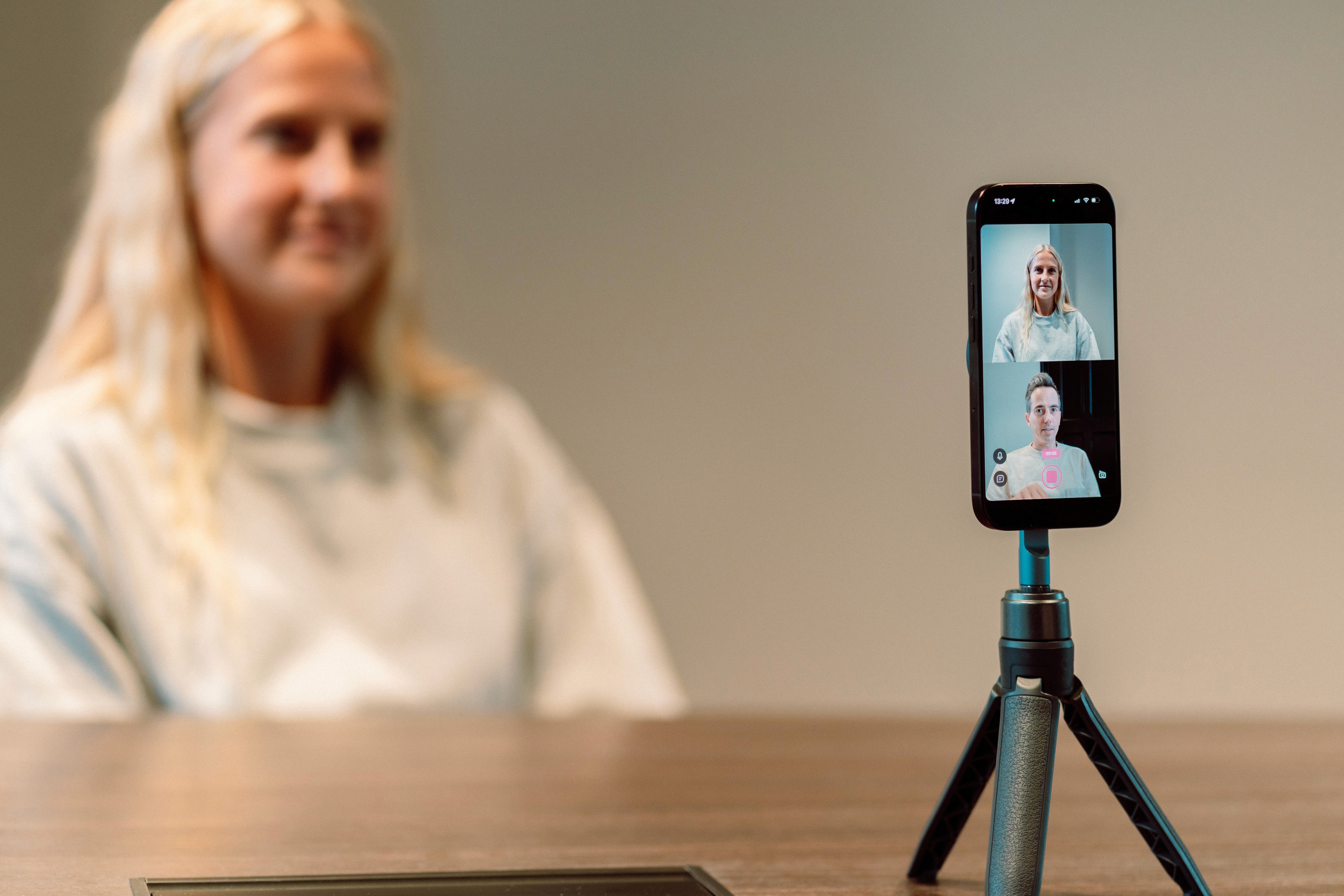

Tips & Tricks
Tips & Tricks
Record Two Angles for Video Podcasts with One iPhone
Record Two Angles for Video Podcasts with One iPhone
Record Two Angles for Video Podcasts with One iPhone
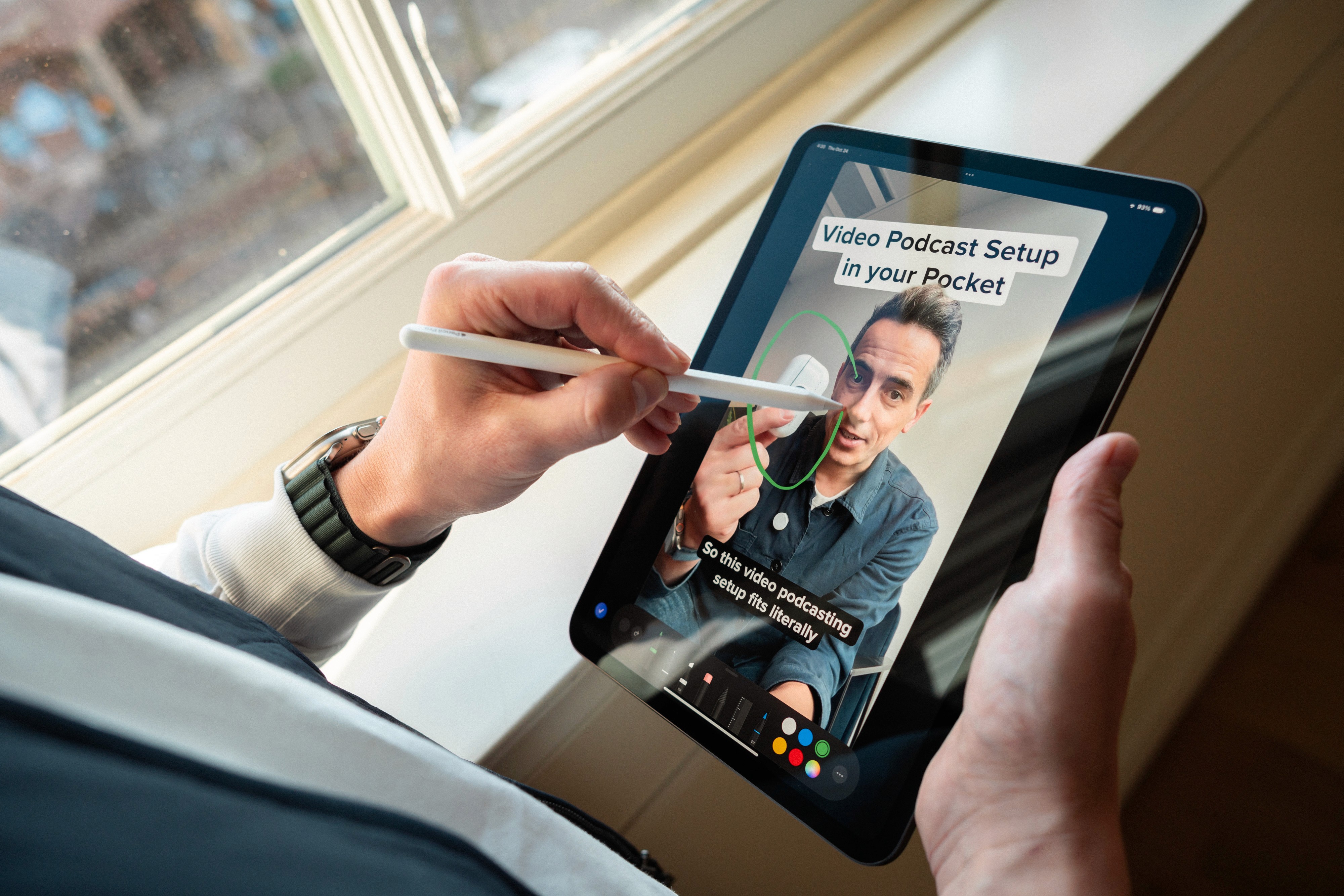

Tips & Tricks
Tips & Tricks
Draw on Videos on iPhone or iPad
Draw on Videos on iPhone or iPad
Draw on Videos on iPhone or iPad
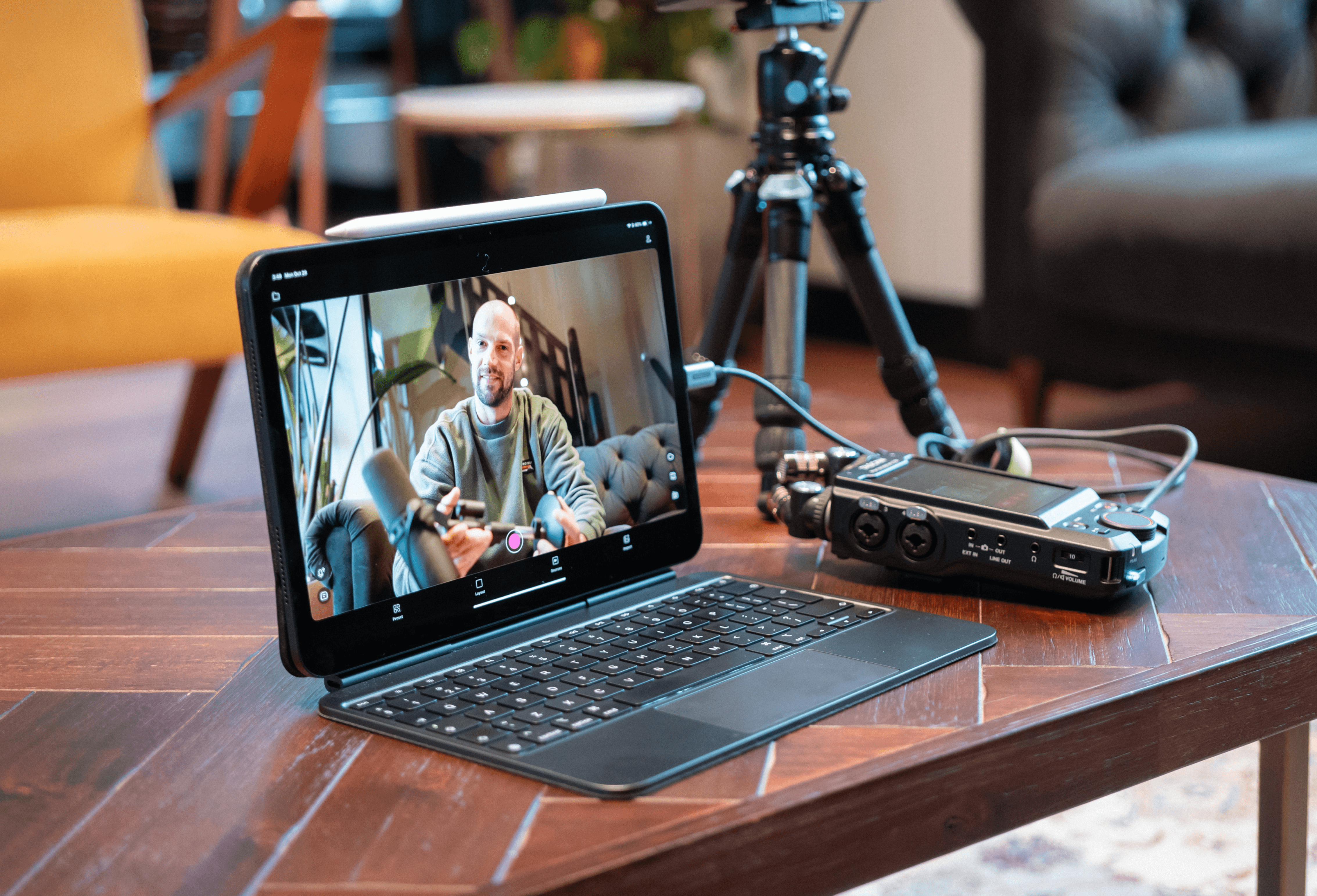

Tips & Tricks
Tips & Tricks
Use Your iPhone's Rear Camera and See Yourself on iPad
Use Your iPhone's Rear Camera and See Yourself on iPad
Use Your iPhone's Rear Camera and See Yourself on iPad
Sign up for news and resources
Unsubscribe at any time.
Support
© 2025 Detail Technologies B.V. All rights reserved
Sign up for news and resources
Unsubscribe at any time.
Support
© 2025 Detail Technologies B.V. All rights reserved
Sign up for news and resources
Unsubscribe at any time.
Support
© 2025 Detail Technologies B.V. All rights reserved
